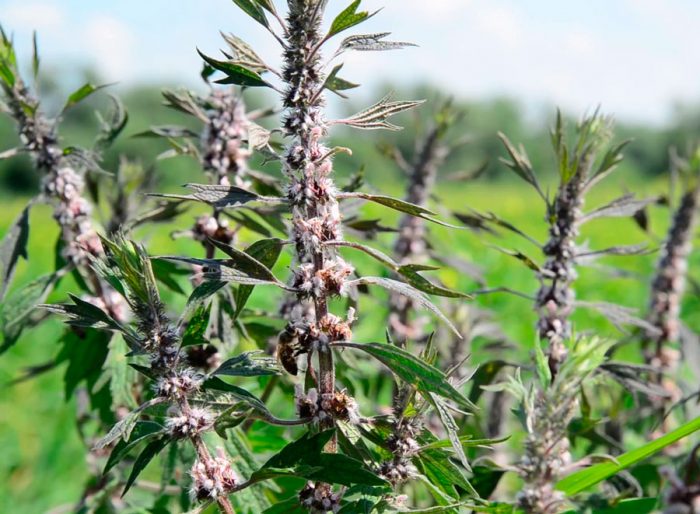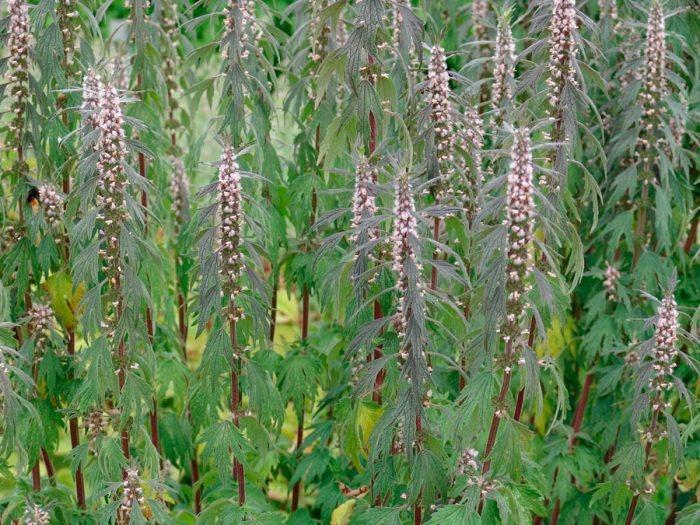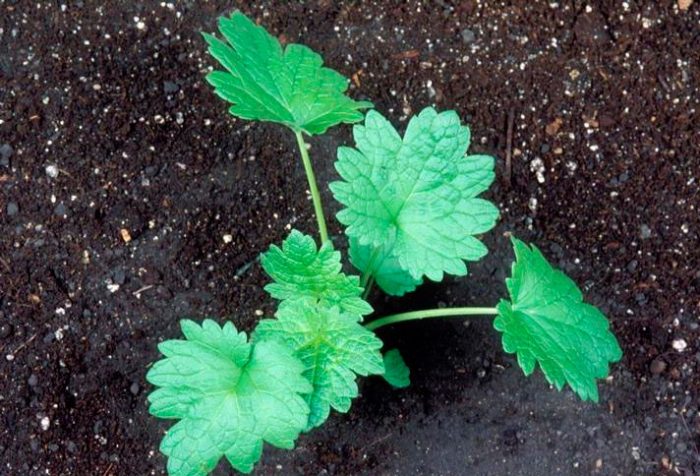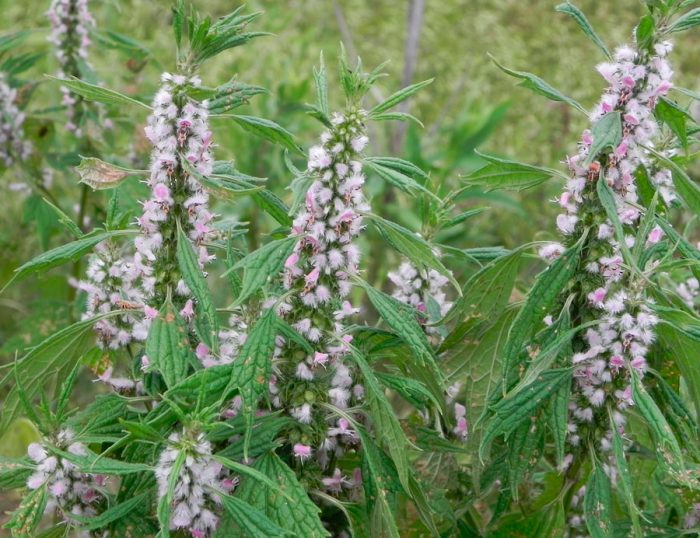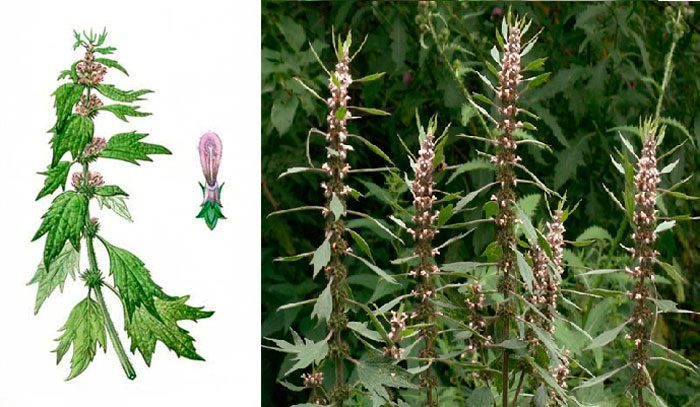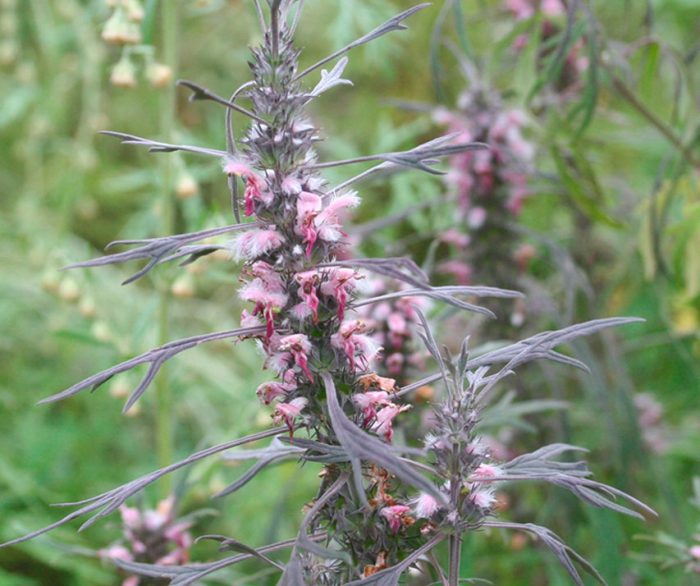A herbaceous biennial or perennial plant motherwort (Leonurus) is a member of the Labiate or Lamiaceae family. These plants are widely distributed in natural conditions in Eurasia (Siberia, Europe, the Middle East and Central Asia). Several species of motherwort also grow in North America. This culture prefers to grow on wastelands, railway embankments, garbage places, and also in quarries, cliffs and along river banks. Healing properties are possessed by 2 types, namely: heartwort and motherwort hairy (five-lobed).
Content
Motherwort features
The height of the motherwort can vary from 0.3 to 2 meters. It has a taproot and an erect tetrahedral stem, which is sometimes branched. The length of the lower palmate-lobed or palmate-divided leaf plates is about 15 centimeters. The upper leaf plates are sometimes solid; as they approach the apex, their size decreases. All leaves have petioles. At the ends of the shoots or in the leaf axils, spike-shaped intermittent inflorescences are formed, consisting of small flowers. The fruit is a coenobium, which includes 4 evenly developed parts. Most of the species are considered good honey plants.
Growing motherwort in the garden
Planting motherwort
Motherwort can be grown in the same place for 3 to 5 years. This plant is drought tolerant and has no special requirements for soil composition. Freshly harvested seeds have a low germination rate. To increase it after the seeds are harvested, they are ripened for 60 days, after which their germination rate increases to 85 percent. At a soil temperature of 4-6 degrees, as well as optimal moisture, seedlings will appear already 4 or 5 days after sowing. Seeds are sown before winter or at the beginning of spring. If sowing is planned for spring, then immediately before it the seeds must undergo stratification, for this they are placed on a refrigerator shelf for vegetables for 4-6 weeks, before that they are poured into a plastic container or a plastic bag, which must be filled with moistened sand ( 1: 3).
In autumn, seeds are sown dry 7–10 days before the first frost and buried into the soil by 10–15 mm. For spring sowing, the seeds should be deepened by 20 mm. The approximate row spacing is from 0.45 to 0.6 m. When sowing seeds in spring, 15–20 percent less is consumed than when sowing in autumn.
Motherwort care in the garden
When the motherwort seedlings appear, they need to be thinned out, while it should be borne in mind that there should be from 4 to 6 bushes per 100 cm of a row. In the first year, caring for such a plant is very simple, you only need to remove weeds from the site. It only needs to be watered during prolonged drought. Starting from the second year of growth, it will be necessary not only to weed the site, but also to loosen its surface, as well as to prune last year's shoots, and once more in the summer, feed this culture with Nitroammophos, which is introduced into the soil.
Motherwort collection and storage
From the second year of growth, the motherwort should begin to harvest. To do this, cut off all lateral cuttings from the bushes, as well as the upper parts of the stems, the thickness of which should not be more than 0.5 cm.Collect should be done in July, while only 2/3 of the bush should be covered with flowering, and on the rest there should still be buds. Harvesting should be done in the morning, immediately after the dew has melted. Re-harvesting is carried out 6 weeks after the first.
The harvested motherwort should be spread in a thin layer in a shaded place. During drying, the raw material should be periodically turned over and agitated. You can also dry this plant in another way: it is tied in small bunches, and then suspended from the ceiling, while the selected room should be well ventilated (for example, a balcony, attic or veranda). You can also use a grass dryer, but it should be borne in mind that the temperature in the chambers should not exceed 50 degrees. It is quite simple to check the readiness of the raw material: the shoot should break easily with light pressure, and the foliage should be rubbed into dust with your fingers. Dried motherwort has a bitter taste and specific aroma. For storage, the herb can be placed in cardboard boxes, fabric bags or in bags made of thick paper. It is removed to a cool, dry place, protected from direct sunlight. If all the rules are followed during storage, the raw materials will retain their medicinal properties for three years.
Types and varieties of motherwort with photos and names
The motherwort genus unites 24 species, they are divided into five subsections. It is interesting that in non-traditional medicine of eastern countries (Korea and China), some types of this plant are used as healing ones, and in various European countries completely different types are used in folk medicine. Below, those species that are cultivated by gardeners will be described.
Gray motherwort (Leonorus glaucescens)
The bush has a gray color due to the fact that it is covered with dense dense pubescence, consisting of pressed hairs directed downward. The color of the flowers is pale pink.
Motherwort tatar (Leonorus tataricus)
The stem has a pubescence in the upper part, consisting of long hairs. The bare leaf plates are thinly dissected. The flowers are purple-pink in color.
Motherwort (Leonorus cardiaca), or motherwort heart
This perennial herb has a woody short rhizome, from which lateral roots extend, they are not very deep in the ground. Ribbed tetrahedral erect shoots are hollow inside in the upper part branched. They can be colored violet-red, but most often green, and there are many protruding long hairs on their surface. The height of the stems varies from 0.5 to 2 meters. Opposite petiole leaf plates gradually decrease in size as they approach the apex. The front surface of the leaves is painted in a pale or dark green color, and the back has a light gray tint. The lower leaf plates are five-partite, round or ovoid, the middle ones are three-partite or three-lobed, with wide serrated lobes, oblong-lanceolate or lanceolate, and the upper ones are simple with lateral teeth.The spike-shaped apical inflorescences consist of small pink flowers sitting in whorls. The fruit contains dark brown nuts. In Europe, this species is cultivated as a medicinal one.
Motherwort five-lobed (Leonorus quinquelobatus), or hairy motherwort
Some scientists believe that this species is a species of common motherwort. Be that as it may, their ranges completely coincide. In this species, in contrast to the common motherwort, the middle and lower leaf plates are five-part, and the upper ones are three-lobed. The surface of the stem is covered with protruding long hairs.
Motherwort properties: harm and benefit
The medicinal properties of motherwort
Motherwort herb contains flavonoids (quercetin, rutin, quinqueloside and others), alkaloids, saponins, essential oil, tannins, organic acids (malic, vanillic, citric, tartaric, ursolic), vitamins A, C and E, potassium, calcium , sulfur and sodium.
The fact that motherwort herb has medicinal properties became known for a long time. Doctors and pharmacists who lived in the Middle Ages used this plant very widely in their practice, but gradually they forgot about it. Only at the end of the 19th century, they remembered it, while in the thirties of the 20th century, scientists proved that the sedative effect of medicinal valerian preparations is 1.5 lower than those made on the basis of motherwort. This plant helps to strengthen the myocardium, stabilize the heart rate, as well as increase myocardial contraction in tachycardia, myocarditis, cardiosclerosis, coronary heart disease, angina pectoris and heart failure of 1-3 degrees. This herb lowers cholesterol levels, helps lower blood pressure in hypertension, reduces the amount of glucose and lactic acid in the blood, and it also has an antispasmodic and anticonvulsant effect.
Motherwort is also quite often used in the treatment of diseases of the organs of the gastrointestinal tract, for example: with gastritis, flatulence, catarrh of the large intestine, spasms, colitis, neuroses, etc. This herb also has an expectorant and anti-inflammatory effect, and its sedative effect on the body it is used during the therapy of insomnia, psychasthenia, hysteria, thyrotoxicosis and vegetative-vascular dystonia.
Motherwort is also used in gynecology for uterine bleeding, painful and unstable regulation, and for climacteric syndrome. This herb is also used in the treatment of epilepsy, chronic cough and Graves' disease, and its seeds are prescribed for glaucoma. Motherwort is contained in such pharmaceutical preparations as: motherwort tincture, sedative collection No. 2, Phytosedan, motherwort herb, Motherwort forte Evalar tablets (with vitamin B6 and sodium carbonate), Motherwort forte, Motherwort P, motherwort extract in tablets.
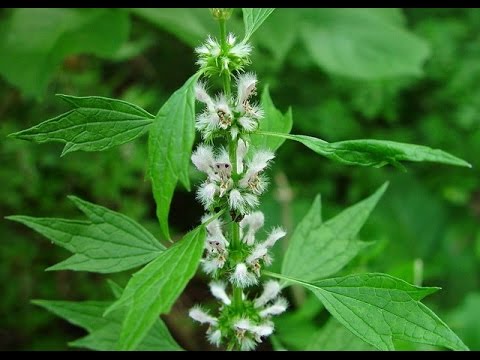

Watch this video on YouTube
Contraindications
Motherwort can cause allergic reactions in some people. Also, preparations based on motherwort cannot be used by those who have an individual intolerance to this herb. It has a stimulating effect on the smooth muscles of the uterus; therefore, it is not recommended to use it for pregnant women, as well as for women after an abortion. Also, motherwort is not recommended for people with erosive gastritis, stomach ulcers, or arterial hypotension. And it should also be borne in mind that preparations made on the basis of motherwort cause drowsiness, so they must be taken with caution by people whose activities are associated with increased concentration of attention.

